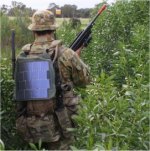The Australian National University says it will seek to commercialise its design of a wearable solar panel system for soldiers after successful field tests demonstrated the technology could easily replace heavy battery packs normally used to power combat equipment.
The Soldier Integrated Power System (SIPS) was developed by scientists at the ANU Centre for Sustainable Energy Systems. SIPS will dramatically reduce the weight members of the Australian Defence Force must now carry in order to power an increasingly tech-heavy arsenal.
“Much of the equipment carried by Australian soldiers requires heavy battery packs, such as night-vision goggles, lights, GPS devices and communication systems. Currently, soldiers depend on conventional batteries to power these devices,” said ANU Project Development Manager Dr Igor Skryabin.
Energy Matters reported on the ANU’s plan to integrate SLIVER cells into a solar vest for soldiers in 2011, when nations such as the USA and UK were fitting infantry with portable solar panels and inverters for use in combat missions. But the ANU team were primarily focused on designing a simple system that would ensure the mobility of Australian infantry.
The solar panel system is based on the ANU’s SLIVER solar cell – flexible solar cells the thickness of a human hair but with a high power-to-weight ratio of more than 200 watts per kilogram. They are also bi-facial, allowing either side of the cell to convert light to energy.
In a 72-hour field test under real mission conditions, the ANU flexible panels produced sufficient power to maintain battery charge. In sunny conditions the panels fully charged the batteries.
“The trials were performed by soldiers in a real mission environment with normal usage of power,” Dr Skryabin said. “Based on the success of this demonstration, ANU will be commercialising the project outcomes with industrial partners.”
The SIPS project was a collaboration between the ANU, CSIRO and Tectonica Australia, as part of a $2.3 million contract awarded under round 15 by the Capability and Technology Demonstrator (CTD) Program managed by the Defence Science and Technology Organisation.







































